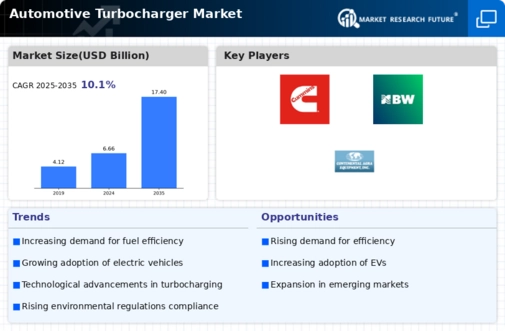Market Growth Projections
The Global Automotive Turbocharger Market Industry is poised for substantial growth, with projections indicating a market value of 6.66 USD Billion in 2024 and an anticipated increase to 17.4 USD Billion by 2035. This growth trajectory suggests a compound annual growth rate of 9.15% from 2025 to 2035, reflecting the increasing adoption of turbocharging technology across various vehicle segments. The market dynamics are influenced by factors such as rising fuel efficiency demands, technological advancements, and regulatory pressures, all contributing to a robust outlook for the industry.
Stringent Emission Regulations
The Global Automotive Turbocharger Market Industry is being propelled by stringent emission regulations imposed by governments worldwide. These regulations aim to reduce greenhouse gas emissions and promote cleaner technologies in the automotive sector. Turbochargers are integral to meeting these standards, as they enable manufacturers to produce engines that comply with emissions limits while maintaining performance. As a result, the demand for turbocharged engines is likely to increase, driving market growth. The anticipated compound annual growth rate of 9.15% from 2025 to 2035 underscores the importance of turbochargers in achieving regulatory compliance and sustainability goals.
Increasing Demand for Fuel Efficiency
The Global Automotive Turbocharger Market Industry is experiencing a surge in demand for fuel-efficient vehicles. As consumers become more environmentally conscious, automakers are compelled to enhance fuel economy without compromising performance. Turbochargers play a pivotal role in achieving this balance, allowing smaller engines to produce more power while consuming less fuel. In 2024, the market is projected to reach 6.66 USD Billion, reflecting a growing trend towards sustainable automotive solutions. This shift is likely to continue, as regulations around emissions tighten globally, further driving the adoption of turbocharged engines.
Growth of Electric and Hybrid Vehicles
The rise of electric and hybrid vehicles is reshaping the Global Automotive Turbocharger Market Industry. While these vehicles primarily rely on electric power, many hybrid models incorporate turbocharged internal combustion engines to enhance performance and efficiency. This trend indicates a shift towards integrating traditional and modern technologies, allowing manufacturers to offer versatile vehicle options. As the market for hybrid vehicles expands, the demand for turbochargers is expected to follow suit, contributing to the overall growth of the industry. The increasing consumer preference for hybrid solutions suggests a promising future for turbocharger applications.
Technological Advancements in Turbocharger Design
Innovations in turbocharger technology are significantly influencing the Global Automotive Turbocharger Market Industry. Manufacturers are focusing on developing advanced materials and designs that enhance performance and durability. For instance, the introduction of variable geometry turbochargers allows for better control of boost pressure, improving engine responsiveness. These advancements not only optimize fuel efficiency but also reduce turbo lag, thereby enhancing the overall driving experience. As the industry moves towards more sophisticated turbocharging solutions, the market is expected to grow, with projections indicating a rise to 17.4 USD Billion by 2035.
Expansion of Automotive Production in Emerging Markets
The Global Automotive Turbocharger Market Industry is benefiting from the expansion of automotive production in emerging markets. Countries such as India and Brazil are witnessing a surge in vehicle manufacturing, driven by rising disposable incomes and urbanization. This growth is leading to an increased demand for turbocharged engines, as manufacturers seek to enhance vehicle performance while adhering to fuel efficiency standards. As these markets develop, the adoption of turbocharging technology is likely to accelerate, further propelling the market forward. The combination of economic growth and automotive innovation presents a favorable landscape for turbocharger manufacturers.














